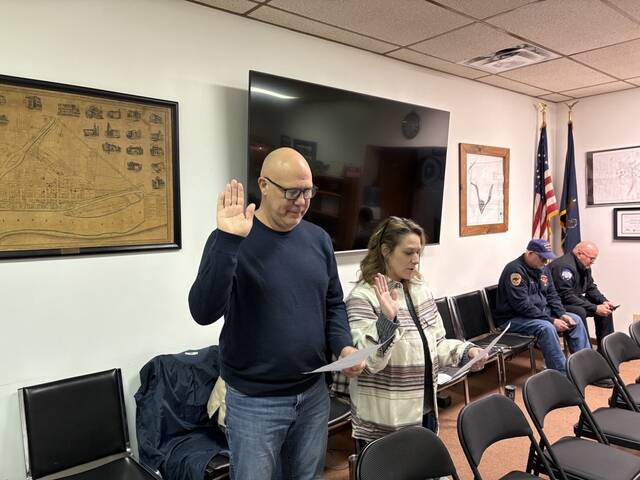Economic development leaders hope to show the Pittsburgh region is a diamond beyond the rough at Oakmont Country Club as the U.S. Open unfolds this week before a national audience.
Tens of thousands of fans are expected to flock to the world-renowned golf course and millions more will tune in on TV, offering a unique opportunity for public officials and civic leaders to sell Western Pennsylvania as a destination to live or do business.
National and international events like the U.S. Open and the 2026 NFL Draft, to be held in Pittsburgh April 23-25, are ways to market the region beyond the boardroom.
“It’s really about the opportunity to literally showcase the region to the people,” said Matt Smith, chief growth officer for the Allegheny Conference on Economic Development, the lead development agency for the 10-county region. “These events are a huge net positive to the region.”
Among those at Oakmont Country Club undoubtedly will be out-of-town business leaders and power brokers that people like Smith want to impress.
“You really can’t put a price tag on it,” he said.
Beyond a networking possibility, the event provides an economic impact, although exactly how much is debatable.
$200M impact?
The United States Golf Association projects the tournament will generate more than $200 million for Pittsburgh’s economy.
The 2024 tournament, held in Pinehurst, N.C., generated $242 million in economic impact to the Tar Heel state that included about $96 million in visitor spending, the USGA said.
But economists handicap the impact of an event like the U.S. Open differently.
“Rule of thumb: Never believe a sports sponsor,” said Victor Matheson, an economic professor at College of the Holy Cross in Worcester, Mass.
Matheson is a former editor of the trade publication Journal of Sports Economics, treasurer and former president of the North American Association of Sports Economists, and co-author of the sports economics textbook “The Economics of Sports.”
“It’s very hard to get to that big of a number,” Matheson said of the USGA’s figures.
Here’s why:
At most there are about 35,000 hotel rooms in the region, tourism officials have said.
If all of those rooms were rented out for the four competition days of the U.S. Open at $200 per room per night, it would generate $28 million. That would be just over 10% of the estimated economic impact of the tournament, although the hotel bill to attend would be among the biggest expenditures. Tickets on Friday were selling for about $50 for a ticket to Monday’s practices, about $240 for a ticket to Thursday’s opening round, or between $1,300 to $2,000 on Stubhub for passes good for all four rounds.
The reason this logic isn’t sound: Not all of the people renting hotel rooms are attending the tournament, Matheson and two other sports economists told TribLive.
Stefan Szymanski is a sports management professor at the University of Michigan, and Michael Leeds is a professor of economics at Temple University in Philadelphia. Each said the economic impact of sporting events is exaggerated and that, in some cases, hosting a large event can be more of a burden than a boon.
Even if the $200 million figure touted by the USGA were exceeded, it would be a trickle — about 0.1% — of the region’s annual economy. Pittsburgh’s gross domestic product — that is, the total market value of the goods produced and services provided here — was $194.2 billion in 2023, according to the Federal Reserve Bank of St. Louis.
“Numbers can seem big,” Leeds said. “We’re not talking about a huge gain.”
Although about 200,000 people are expected for the tournament, that number includes residents who live nearby. For those people, the money they spend this week is money they would have possibly spent elsewhere, Szymanski said.
“All that these things are doing is reallocating consumer leisure spending,” he said. “There’s no local impact from that. It’s a drop in the economy.”
There’s nothing wrong with hosting an event like the U.S. Open, Leeds said.
“If the people of Pittsburgh want to do this, wonderful. Just be honest what the benefits are,” Leeds said. “Don’t tell me it’s going to make me prosperous.”
Going for the green
“That does not mean there’s no effect on anybody,” Leeds said.
In North Carolina, Phil Werz leads the convention and visitors bureau that promotes the Pinehurst area.
“Golf is the lifeblood of this community,” Werz said. “Without golf, we would have nothing.”
The region is still riding high after hosting the 2024 U.S. Open, he said.
“We still see the benefits a year later,” Werz said. “It had a regional effect from Raleigh to Charlotte.”
A tangible figure Werz pointed to is the hotel occupancy tax collected. The tax provides him with the cash to operate the convention and visitors bureau. In June 2023, a year before the tournament, collections totaled about $319,000. Last year, when the U.S. Open was held June 13 through 16, collections were more than $726,000 — a more than 127% increase.
Bernard Dagenais, president and CEO of the Main Line Chamber of Commerce near Philadelphia, also noted the benefits of hosting a golf tournament.
In May, the Philadelphia Cricket Club’s Wissahickon Course hosted the Truist Championship, and like Oakmont, Merion Golf Club in suburban Philadelphia is a USGA anchor that will regularly host U.S. Opens.
“The business impact is considerable,” Dagenais said. “You see the economic activity happening all around: catering companies, hotels, all types of those who serve a tourist population.”
The message Smith, the chief growth officer for the Allegheny Conference, has for the world is simple:
“We can execute these events as well as any other region in the country,” he said. “The region is ready.”











